As an Australian business owner or executive, you're no stranger to operational challenges—missing quarterly growth targets, watching costs spiral, and seeing competitors launch innovative tech solutions that leave you behind. If this sounds familiar, your legacy systems are likely the silent culprit.
Outdated systems aren't just inefficient; they're creating data silos that stifle collaboration, inflate expenses by up to 30% of your IT budget, and deliver poor customer experiences in a market demanding agility. In 2026, with IT spending in Australia projected to exceed A$172 billion, clinging to these legacy systems means falling further behind.
The frustration is real: you're pouring resources into patchwork fixes, facing team resistance to change, and unsure where to even begin modernising. But there's a proven solution that's transforming Australian businesses: cloud-native development.
As a leading custom app development agency, C9 specialises in cloud-native solutions that eliminate silos, enable scalability, and drive data-driven growth for Australian enterprises.
How Data Silos and Inefficiency Cripple Australian Businesses
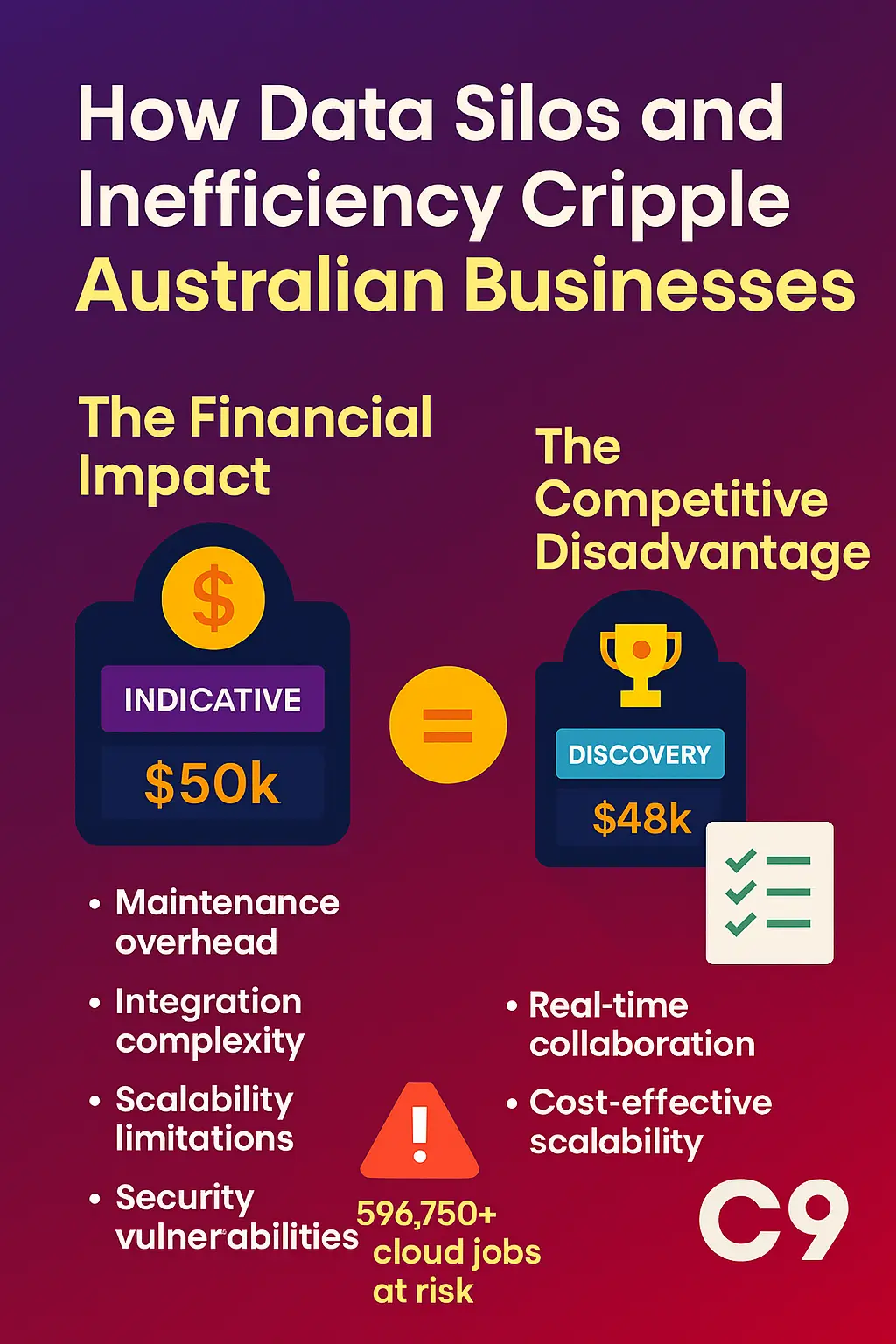
Let's examine the real costs of maintaining legacy systems in 2026:
The Financial Impact
High operational costs from fragmented systems can consume 30% of your technology budget. Poor integration leads to delayed decisions and lost revenue in a competitive landscape where 80% of Australian businesses are migrating to the cloud by 2026.
These costs manifest as:
- Maintenance overhead for outdated technologies requiring scarce, expensive specialists
- Integration complexity with fragile, costly custom connections between isolated systems
- Scalability limitations requiring upfront capital investment that delays market response
- Security vulnerabilities exposing your organisation to breaches costing millions in remediation
The Competitive Disadvantage
Whilst you're struggling with legacy constraints, competitors are leveraging cloud-native applications for:
- Real-time collaboration across teams and locations
- Cost-effective scalability with pay-as-you-go models
- Enhanced security through enterprise-grade cloud infrastructure
- Faster time-to-market with agile development practices
Without action, you risk missing out on the 596,750 new jobs created by public cloud adoption—and more importantly, the competitive advantages this transformation enables.
Breaking Free: Embracing Cloud-Native Development
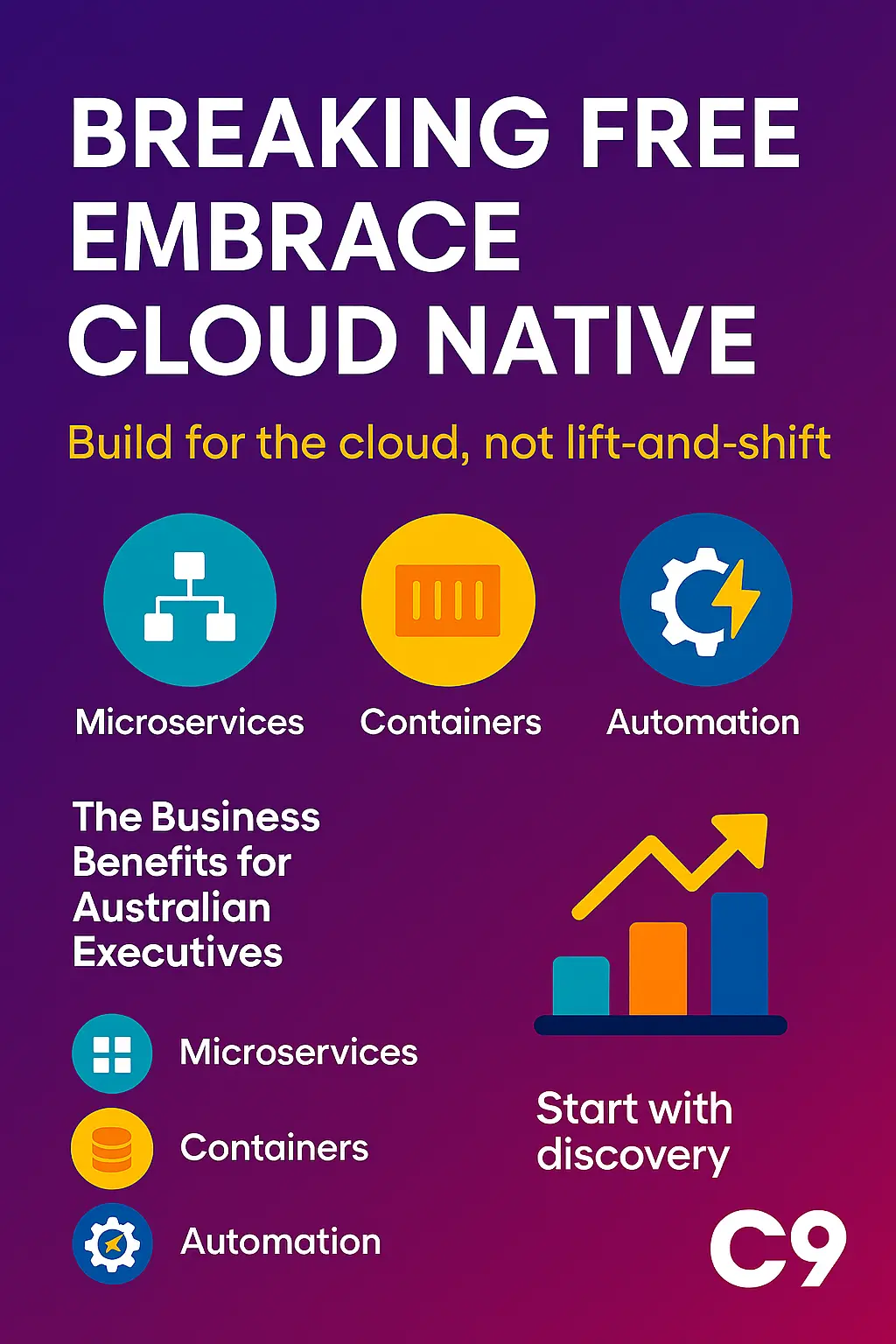
Cloud-native development isn't just moving applications to the cloud—it's building apps designed specifically for cloud infrastructure using microservices, containers, and automation.
What Makes Applications Cloud-Native?
Microservices Architecture: Applications composed of loosely coupled services that can be developed, deployed, and scaled independently, enabling greater agility and resilience.
Containerisation: Packaging applications with all dependencies using technologies like Docker and Kubernetes, ensuring consistent behaviour across environments and enabling efficient resource utilisation.
Automation and DevOps: Automated testing, deployment, and infrastructure provisioning that reduces errors, accelerates delivery, and enables continuous improvement.
API-First Design: Well-defined APIs that enable seamless integration with other systems, eliminating the data silos characteristic of legacy architectures.
The Business Benefits for Australian Executives
Cloud-native development delivers tangible advantages:
Dramatic Cost Reduction: Pay-as-you-go pricing eliminates upfront infrastructure investment. Australian organisations typically realise 30-40% cost savings compared to traditional infrastructure.
Unprecedented Agility: Deploy new features rapidly, test market hypotheses quickly, and pivot strategies without infrastructure constraints.
Enhanced Efficiency: Automation reduces manual tasks, seamless integrations eliminate redundant work, and real-time visibility enables proactive optimisation.
Improved Customer Experience: Deliver responsive, personalised experiences with mobile accessibility, real-time updates, and seamless cross-channel interactions.
Support for Hybrid Work: Enable secure access from any location, supporting productivity whilst maintaining security—critical in 2026's flexible work environment.
2026 Cloud-Native Trends
AI-Native Platforms: Artificial intelligence capabilities embedded directly into cloud platforms, enabling advanced analytics and intelligent automation without specialised teams.
Multi-Cloud Strategies: Leveraging strengths of different cloud providers whilst avoiding vendor lock-in, providing flexibility and resilience.
Edge Computing Integration: Bringing processing closer to data sources for ultra-low latency applications, particularly valuable for IoT and real-time systems.
Sustainability Focus: Cloud providers' massive scale delivers significantly better energy efficiency than enterprise data centres, supporting environmental objectives whilst often reducing costs.
Beware the AI Cowboys: The Risks of Cheap AI App Builders
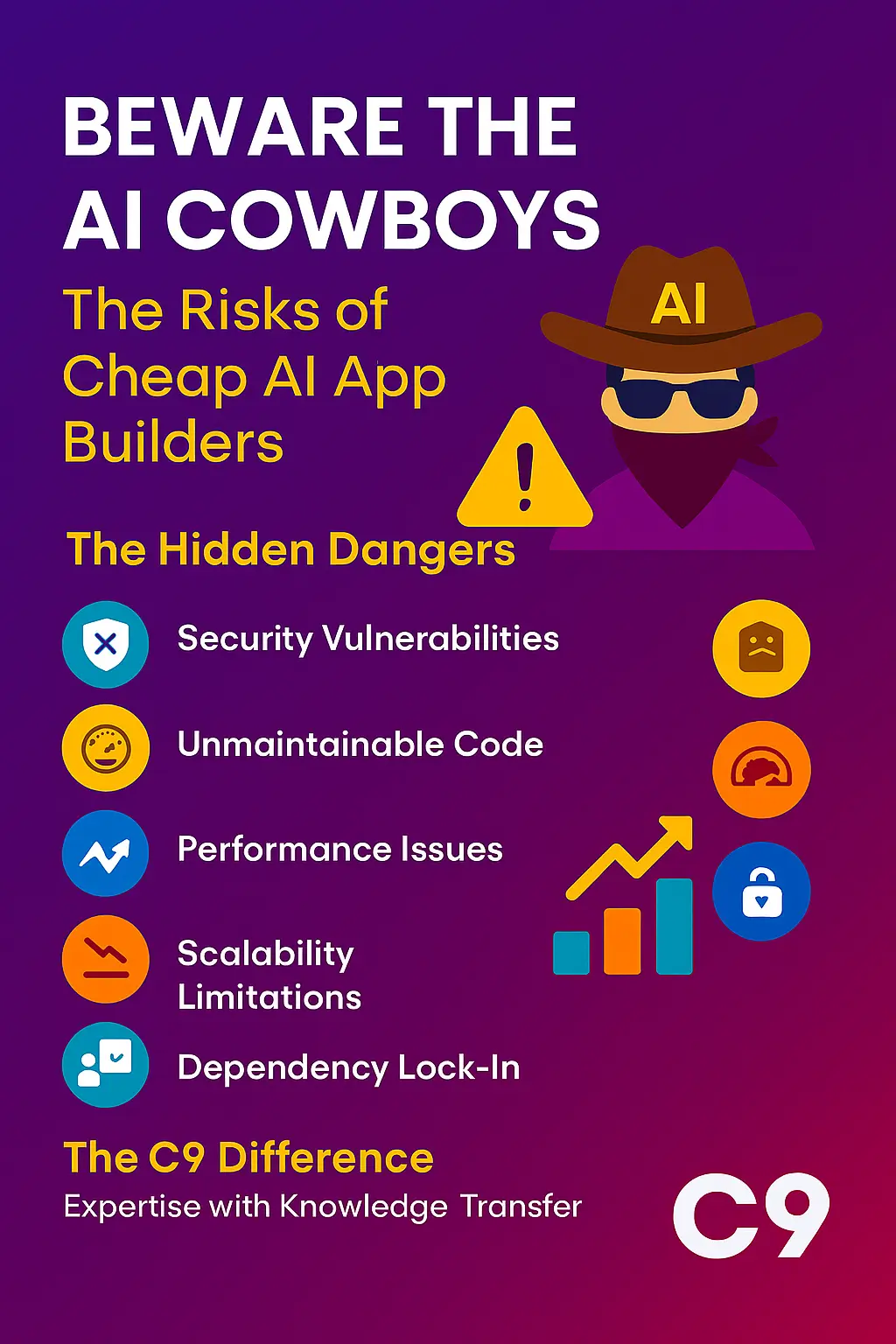
In your urgency to modernise, you might encounter "AI Cowboys"—providers using AI app builders and "vibes coding" (vague descriptions generating code without deep expertise) to promise instant results at minimal cost.
The Hidden Dangers
These shortcuts create serious risks:
Security Vulnerabilities: AI-generated code frequently omits critical security measures like input validation, authentication controls, and data encryption, exposing your organisation to breaches and regulatory penalties under Australian privacy laws.
Unmaintainable Code: Code generated without human refinement lacks architectural coherence, making future enhancements extraordinarily expensive as developers spend more time deciphering logic than implementing improvements.
Performance Issues: AI-generated code prioritises functionality over efficiency, often implementing algorithms that perform adequately during testing but degrade dramatically with production data volumes.
Scalability Limitations: Applications lack the architectural foundations for scaling, working perfectly for current needs but failing catastrophically when customer adoption grows.
Dependency Lock-In: Without documentation or knowledge transfer, you become dependent on specific developers with no ability to engage alternatives or maintain systems internally.
The C9 Difference: Expertise with Knowledge Transfer
At C9, we leverage AI tools to enhance developer productivity, but our applications are architected, reviewed, and refined by experienced professionals. More importantly, we provide comprehensive knowledge transfer:
- Detailed architectural documentation explaining design decisions
- Structured training sessions equipping your team to support and enhance applications
- Code reviews ensuring maintainability and adherence to best practices
- Long-term partnership mindset supporting your evolving needs
This approach builds your internal capabilities rather than creating dependency.
Why Choose C9 Over Other Application Developers?
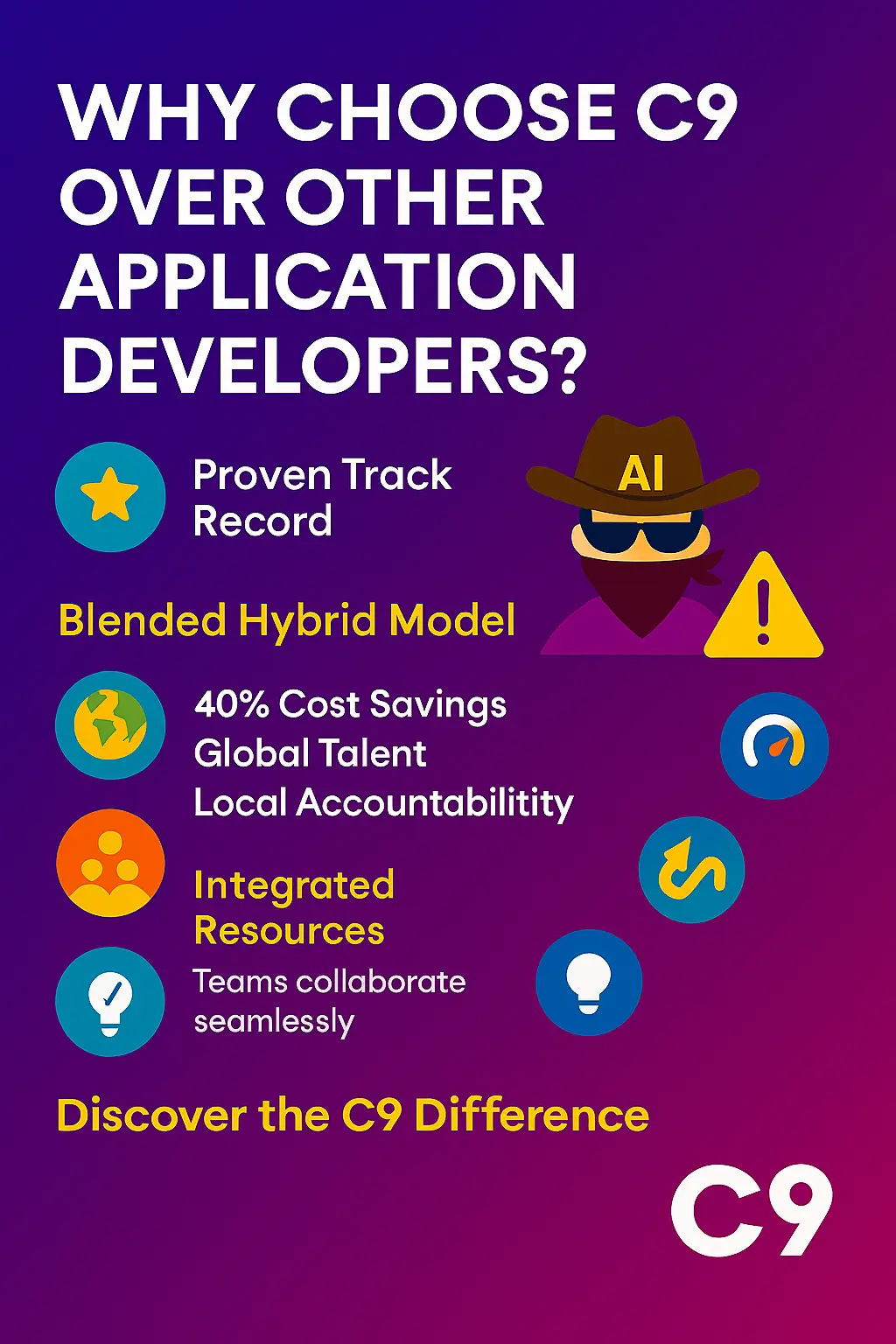
In a crowded field, several factors distinguish C9:
Proven Track Record Across Industries
We've delivered successful projects across financial services, healthcare, retail, manufacturing, government, and education—understanding industry-specific challenges and regulatory requirements that inform our solutions.
Blended Hybrid Offshore and Onshore Model
Our delivery model combines global talent with local Australian expertise, delivering:
- Cost savings up to 40% compared to purely onshore teams
- Local accountability with Australian presence understanding market dynamics and regulations
- Access to specialised talent in emerging technologies and niche platforms
- Quality without compromise through rigorous code reviews and structured methodologies
Multiple Resources for Integrated Projects
Unlike solo contractors, we provide integrated teams where specialists collaborate seamlessly—user experience designers, backend developers, database architects, and DevOps engineers working in unified frameworks.
Knowledge Transfer as Core Value
We build your internal capabilities through collaborative development, comprehensive documentation, training workshops, and transition planning—ensuring you're not permanently dependent on external resources.
Visit https://www.c9.com.au/ to explore case studies demonstrating how our solutions have driven efficiency and growth for Australian businesses.
Flexible Staff Augmentation Options
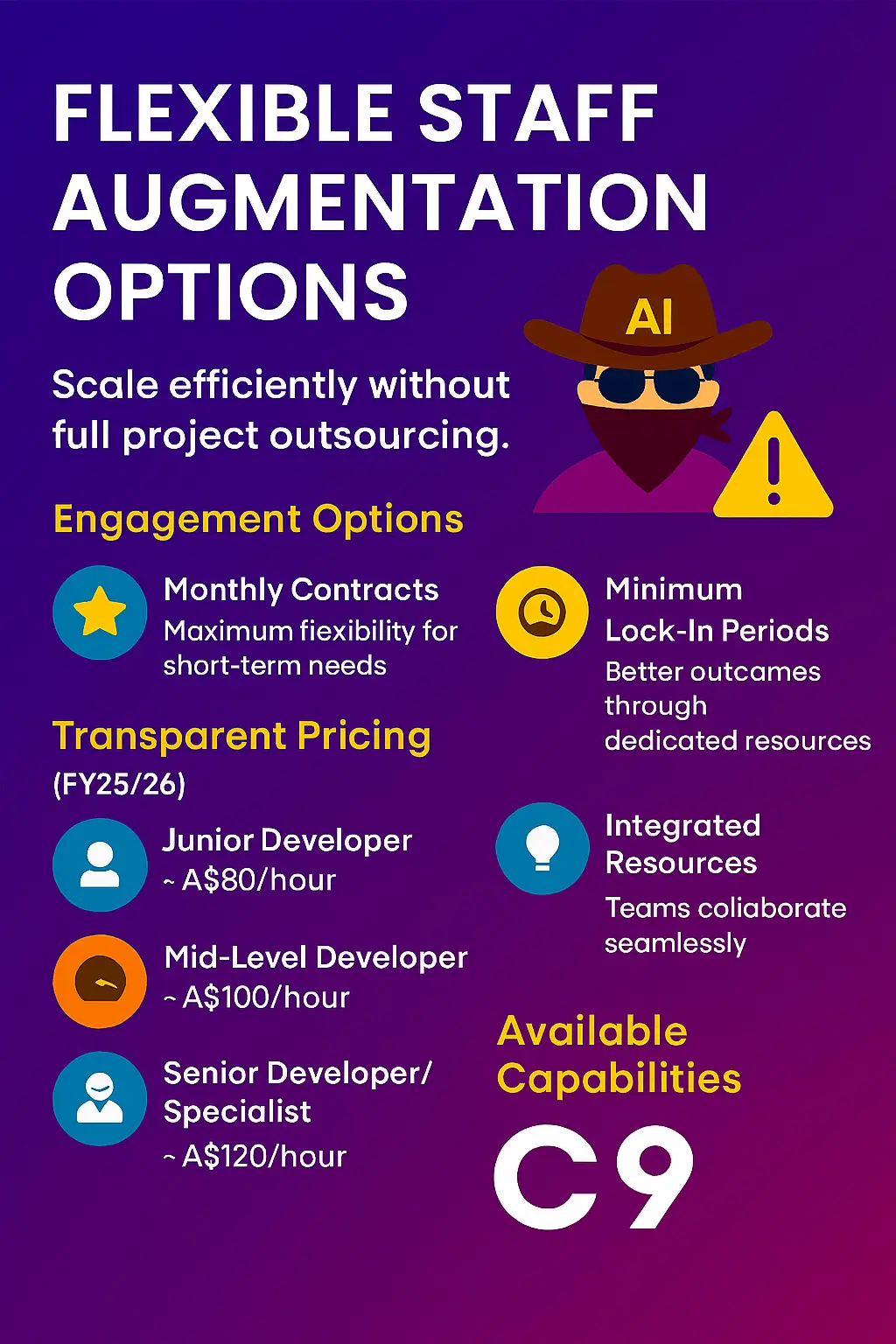
Need to scale without full project outsourcing? C9's staff augmentation provides flexible access to our integrated teams.
Engagement Options
Monthly Contracts: Maximum flexibility for short-term needs or experimental initiatives.
Minimum Lock-In Periods (3-6 Months): Better outcomes through dedicated resources, deeper collaboration, and consistent progress avoiding monthly churn disruptions.
Transparent Pricing (FY25/26)
- Junior Developers: ~A$80/hour (1-3 years experience)
- Mid-Level Developers: ~A$100/hour (3-6 years experience)
- Senior Developers/Specialists: ~A$120/hour (6+ years experience)
These rates assume onshore-offshore mix, with discounts available for long-term or multi-resource (>3) contracts.
Available Capabilities
Unlike providers supplying isolated contractors, we offer integrated specialists who collaborate effectively.
The Power of Discovery Calls: Essential for Success
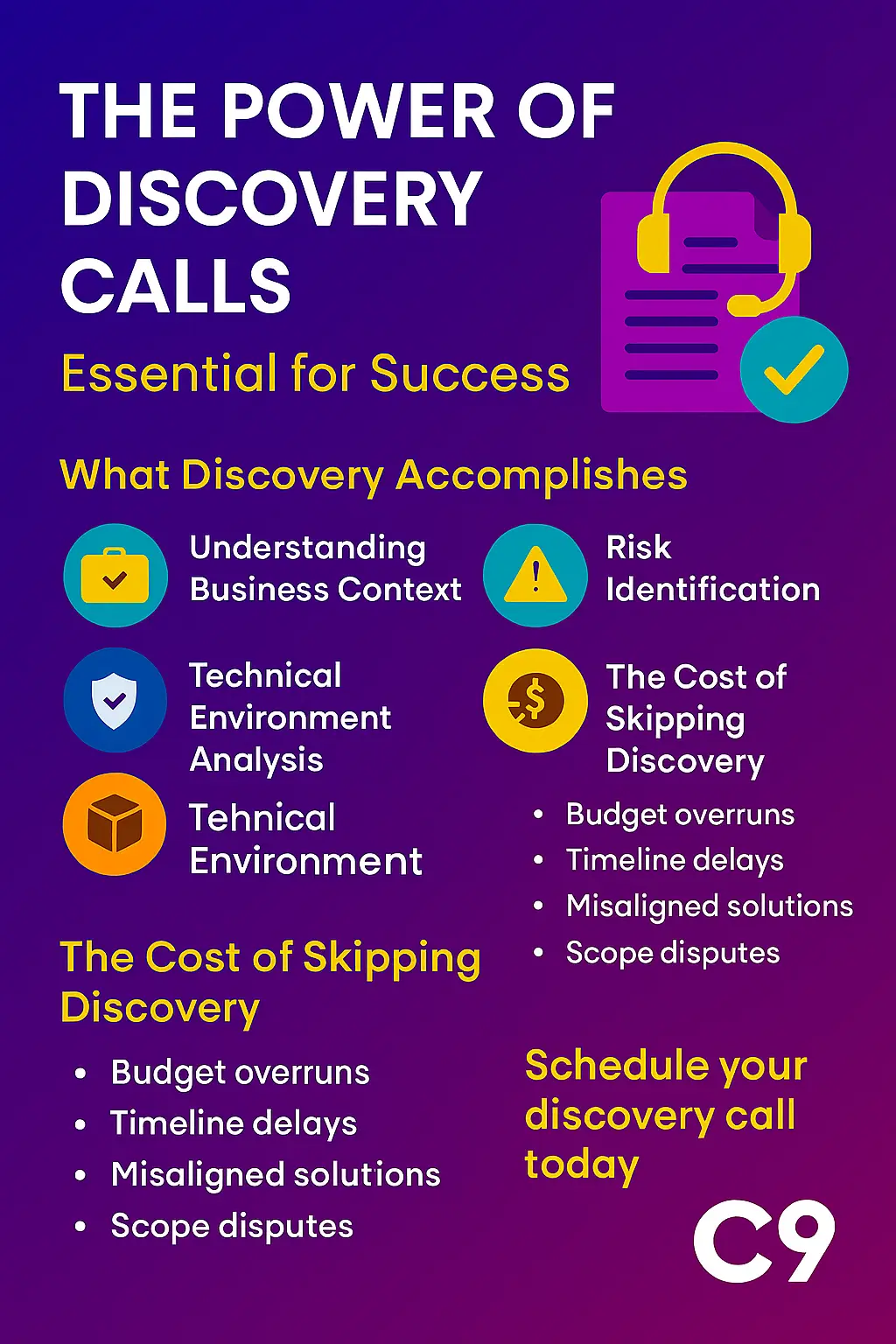
Discovery calls aren't just chats—they're essential for mapping your project's requirements, timelines, and decision points, turning uncertainty into clear roadmaps.
What Discovery Accomplishes
- Understanding Business Context: Problems you're solving, success metrics, strategic importance
- Technical Environment Analysis: Existing systems, integration requirements, security/compliance needs
- Solution Exploration: Architectural approaches, technology stacks, feature prioritisation
- Risk Identification: Potential roadblocks, dependencies, assumptions requiring validation
- Phased Roadmap: Incremental value delivery, early ROI opportunities
The Cost of Skipping Discovery
Organisations that skip discovery inevitably experience:
- Budget overruns when hidden requirements emerge mid-project
- Timeline delays from mid-stream redesigns addressing constraints discovered late
- Misaligned solutions that don't address actual workflows or needs
- Scope disputes about what was included in original agreements
Investment: Discovery typically requires 3-5 hours across multiple sessions, but prevents problems costing exponentially more to address later.
C9's Discovery Process
Our collaborative approach builds trust whilst providing immediate value:
- Understanding pain points and goals (30-45 minutes)
- Technical environment analysis (45-60 minutes)
- Solution exploration and prioritisation (60-90 minutes)
- Roadmap and phasing strategy (30-45 minutes)
The outcome is comprehensive documentation becoming the foundation for accurate estimation and informed decision-making.
Why Discovery-Based Pricing Beats Indicative Quotes
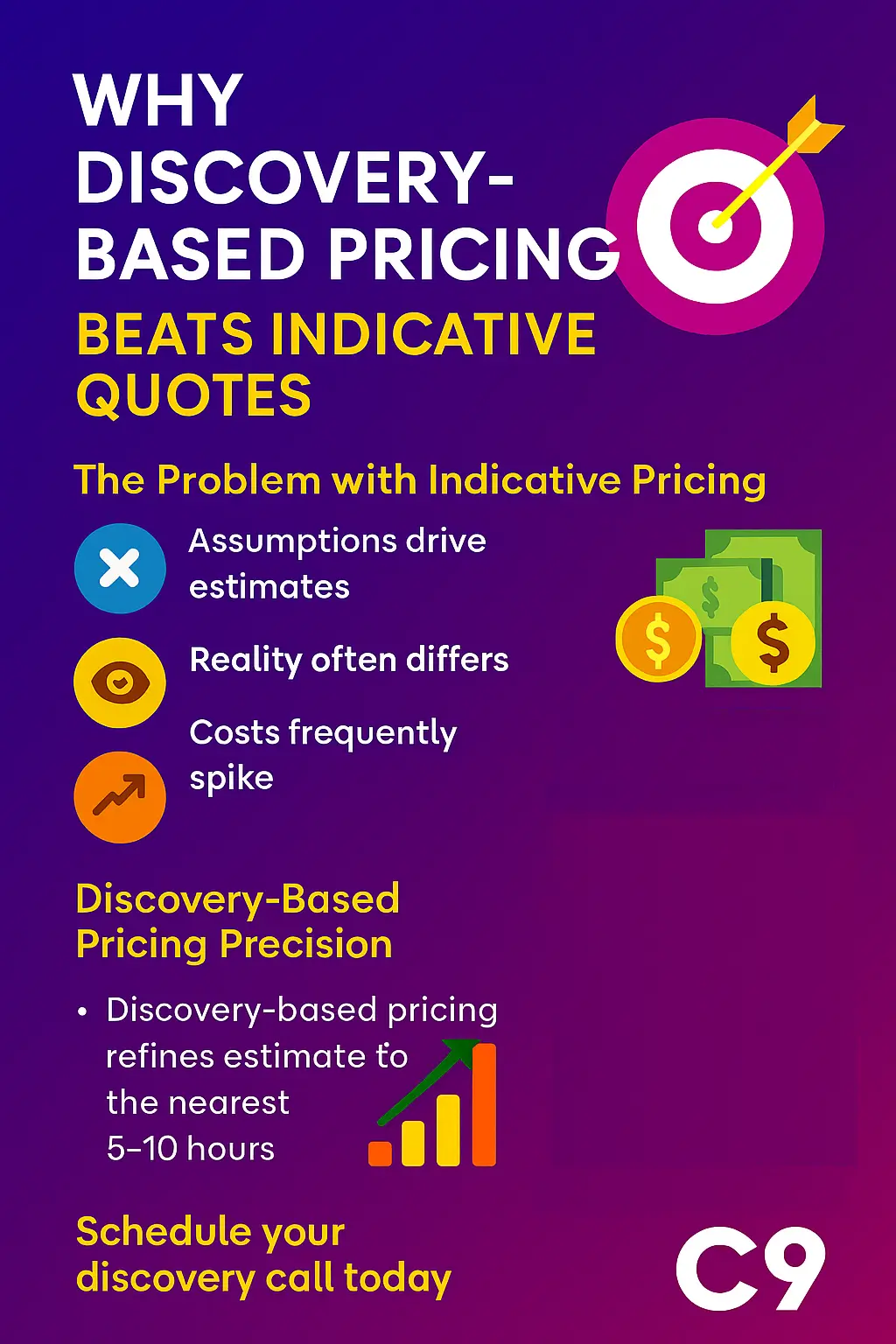
"Indicative pricing" sounds attractive—quick estimates enabling budget planning without extensive discovery. The reality? These estimates are frequently not worth the paper they're written on.
The Problem with Indicative Pricing
Indicative quotes rely on assumptions about scope, complexity, and requirements. When reality differs—as it inevitably does—estimates become meaningless.
Example: An indicative quote pegs a cloud-native app at A$50,000 "to the nearest week." Reality hits with A$75,000 due to uncovered integration requirements, performance optimisation needs, and compliance obligations not apparent initially.
Discovery-Based Pricing Precision
Discovery-based pricing refines estimates to the nearest 5-10 hours:
Example Breakdown:
- User authentication: 40 hours
- Dashboard development: 60 hours
- CRM integration: 80 hours
- Mobile responsive interface: 120 hours
- Testing and QA: 80 hours
- Deployment: 30 hours
- Total: 410 hours × A$100/hour = A$41,000
This granular estimation achieves ±10-15% accuracy compared to indicative pricing's ±50% or worse.
Phased Approach Benefits
Discovery enables breaking projects into phases:
- Phase 1 (MVP): Core functionality—200 hours, A$20,000
- Phase 2 (Enhancement): Additional capabilities—150 hours, A$15,000
- Phase 3 (Optimisation): Advanced features—60 hours, A$6,000
Benefits include early ROI, risk mitigation, flexibility to adjust between phases, and incremental investment based on validated assumptions.
Secure Your Competitive Edge with C9 Today
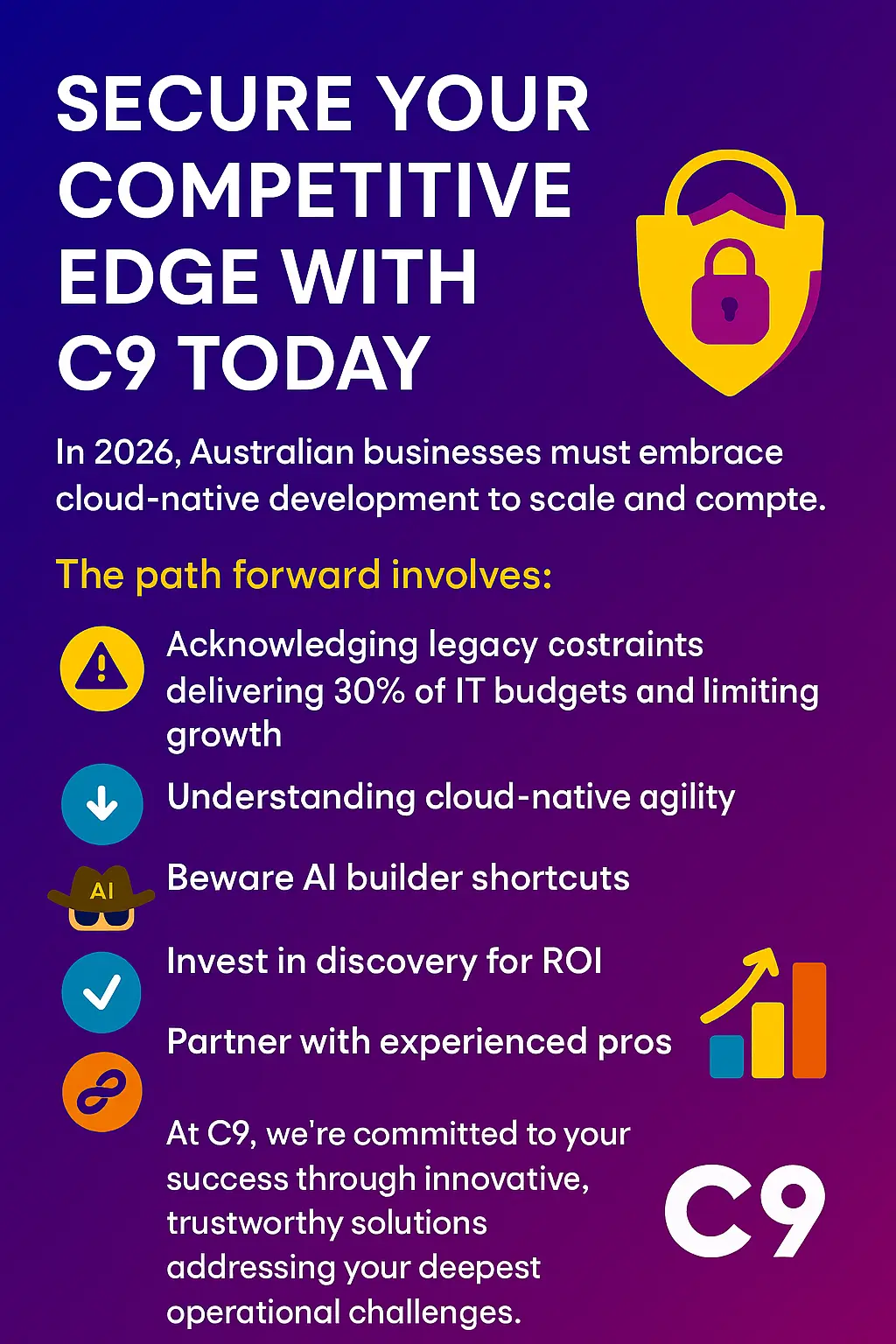
Australian businesses face a clear choice in 2026: embrace cloud-native development to scale, integrate, and grow—or fall further behind competitors who've already made the leap.
The path forward involves:
- Acknowledging legacy constraints costing 30% of IT budgets and limiting growth
- Understanding cloud-native benefits delivering 30-40% cost savings and unprecedented agility
- Avoiding shortcuts like AI Cowboys that promise quick wins but deliver technical debt
- Investing in discovery to ensure projects align with actual needs and deliver ROI
- Partnering with proven experts who build your capabilities whilst delivering solutions
At C9, we're committed to your success through innovative, trustworthy solutions addressing your deepest operational challenges.
Take Action Now
Ready to revolutionise your business operations? Book a discovery call with C9 today at https://www.c9.com.au/
Let's collaborate on custom app development services that:
- Eliminate data silos hindering collaboration
- Reduce operational costs through cloud-native efficiency
- Enable scalability supporting your growth ambitions
- Deliver competitive advantages in your market
- Build your internal capabilities for long-term independence
Don't let legacy systems define your competitive ceiling. Join the 80% of Australian businesses embracing cloud transformation in 2026.